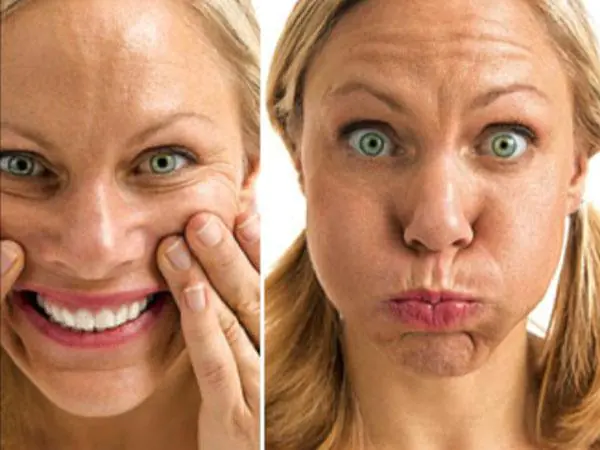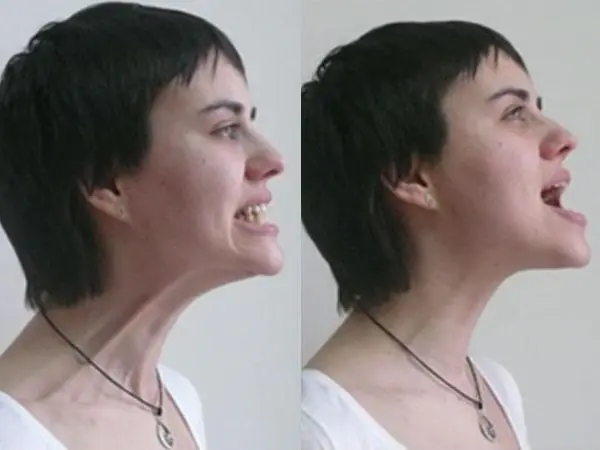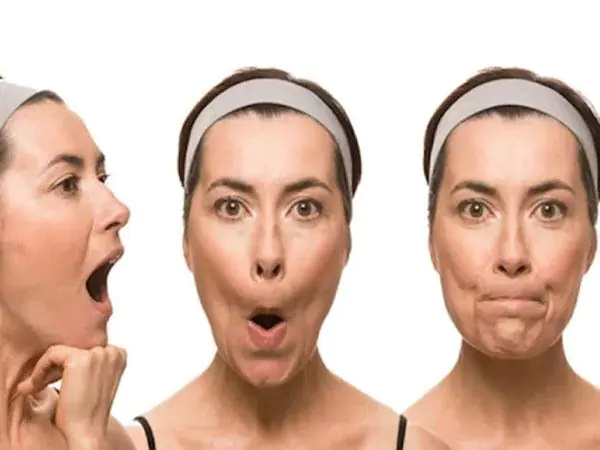Fatigue, lack of sleep, eating disorders, bad mood, vagaries of weather - all these circumstances have a bad effect on our appearance. The face especially suffers: the skin becomes flabby, loses its healthy color, becomes covered with wrinkles, areas of swelling and dark circles appear under the eyes. It is not always possible to protect yourself from the effects of aggressive factors, but we are able to minimize its consequences. For this purpose, cosmetics are usually used and procedures are performed to help moisturize the skin, nourish it with useful substances, and increase elasticity and firmness. Unfortunately, such care is often not enough: superficial procedures do not give the expected effect due to a decrease in the tone of the facial muscles. However, there is no need to despair. There is a set of simple exercises that any woman can tighten her facial skin by doing regularly.
Circular eye massage
Make fists with your hands so that your thumbs are on top. Close your eyes and massage your eyelids with your fists in a circular motion (several times clockwise, then several times in the opposite direction). Touching the eyelids should be very gentle, without applying pressure.
Exercise helps increase blood flow and tone the muscles around the eyes. As a result, the skin tightens, dark circles and bags under the eyes disappear.
"Astonishment"
Try to open your eyes as wide as possible and even bulge them for a few seconds. Then close your eyes tightly. Alternate these movements at a fast pace for 2-3 minutes. After finishing, relax your facial muscles and sit quietly for 3-4 minutes, closing your eyes.
Exercise helps tone the muscles of the upper half of the face and relieves eye fatigue.
Cheek puffing
Inhale deeply through your mouth and hold your breath, puffing out your cheeks. Slowly release air from your mouth through half-closed lips. Repeat 10-12 times.
This is exactly how the facial muscles work for musicians who play wind instruments and, due to their occupation, are forced to constantly strain the muscles of their cheeks. With such training, the oval of the face retains clear contours even at a very advanced age, the cheeks do not sag or become covered with wrinkles.
"Kisses"
Smile as wide as possible, and then quickly draw out your lips. Repeat the movements 20-25 times.
The purpose of the exercise is to increase the tone of the muscles that control lip movements. In addition, according to scientists, there is not only a direct relationship between the production of so-called happiness hormones and facial expression, but also an inverse one. Moving your lips to create a smile triggers the release of serotonin and actually improves your mood.
Ear pulling
Pinch your earlobes with your fingers and pull down for 30 seconds. Then pull the lobes up for 30 seconds and twist them clockwise and back for another half a minute.
The effect on the earlobes causes a rush of blood to the brain, invigorates, and enhances physical and intellectual activity. The procedure is also useful for improving appearance: if performed regularly, you can significantly slow down the formation of wrinkles, which greatly spoil the skin under the ears and in the upper part of the neck.
Relaxation
Press your index, middle and ring fingers against your eyebrows. For 3-4 minutes, gently stretch your eyebrows in opposite directions.
The exercise helps strengthen the subcutaneous muscles located on the forehead and reduce vertical wrinkles between the eyebrows. In this case, the relationship between facial expression and emotions is also triggered: the procedure promotes relaxation, stress relief and getting rid of difficult thoughts.
The good thing about the complex is that its daily implementation does not require a specially prepared place or a lot of time. Exercises can be done at home or at work during breaks. Such gymnastics for facial muscles not only improves the condition of the face, but also refreshes, elevates the mood, helps to concentrate, increase productivity and be resistant to stress.
Video from YouTube on the topic of the article:

Education: First Moscow State Medical University named after I.M. Sechenov, specialty "General Medicine".
Found an error in the text? Select it and press Ctrl + Enter.
In order to say even the shortest and simplest words, we use 72 muscles.
During operation, our brain expends an amount of energy equal to a 10-watt light bulb. So the image of a light bulb above your head at the moment an interesting thought arises is not so far from the truth.
Even if a person's heart does not beat, he can still live for a long period of time, as the Norwegian fisherman Jan Revsdal demonstrated to us. His “engine” stopped for 4 hours after a fisherman got lost and fell asleep in the snow.
The average life expectancy of left-handers is shorter than that of right-handers.
Research shows that women who drink several glasses of beer or wine per week have an increased risk of developing breast cancer.
Dentists appeared relatively recently. Back in the 19th century, pulling out diseased teeth was the responsibility of an ordinary hairdresser.
When we sneeze, our body stops working completely. Even the heart stops.
74-year-old Australian resident James Harrison has donated blood about 1,000 times. He has a rare blood type whose antibodies help newborns with severe anemia survive. Thus, the Australian saved about two million children.
The highest body temperature was recorded in Willie Jones (USA), who was admitted to the hospital with a temperature of 46.5°C.
According to WHO research, talking on a mobile phone for half an hour every day increases the likelihood of developing a brain tumor by 40%.
People who eat breakfast regularly are much less likely to be obese.
Regular use of a solarium increases your chance of developing skin cancer by 60%.
According to many scientists, vitamin complexes are practically useless for humans.
American scientists conducted experiments on mice and came to the conclusion that watermelon juice prevents the development of vascular atherosclerosis. One group of mice drank plain water, and the second group drank watermelon juice. As a result, the vessels of the second group were free of cholesterol plaques.
When lovers kiss, each of them loses 6.4 calories per minute, but at the same time they exchange almost 300 types of different bacteria.
Every person can face a situation where they lose a tooth. This may be a planned procedure performed by dentists, or the result of an injury. In each and.
Guys, we put our hearts into Bright Side. Thank you for that
that you are discovering this beauty. Thanks for the inspiration and goosebumps.
Join us on Facebook and VKontakte
Everyone knows that old age is primarily manifested in wrinkles and sagging skin. But the elasticity of the skin itself and the contour of our face depend on how good the tone of the facial muscles is. To keep your facial muscles toned, just like in fitness, you need proper and effective exercises.
That's why Bright Side publishes a set of the best exercises that, according to doctors, will help your face stay fit and young for many years.
To ensure that your efforts are not in vain, before starting any “training,” the muscles need to be properly stretched and warmed up.
Sit or stand with your back straight. Now try to pronounce vowel sounds as clearly and drawn out as possible (“a”, “o”, “i”, “e”). Take your time and continue the exercise until you feel warmth all over your face.
Sit on a chair and tilt your head back. Now imagine that you need to reach a light bulb with your lower lip. Protrude your lower lip as much as possible and hold in this position for 5-10 seconds. Then relax and repeat 2-3 more times.
You can look luxurious at any age. Modern aesthetic medicine offers a wide selection of hardware procedures and beauty injections. Facelift exercises continue to be popular - an affordable way to maintain youth. Regular training will allow you to stop age-related changes, even if you don’t have time.
Benefits of facial exercises
An ideal oval shape, an even, smooth skin structure; similar results can be achieved without regularly visiting a cosmetologist. Effective gymnastics will strengthen muscle fibers, restore oxygen breathing, and cell regeneration. After 25 years, the synthesis of collagen and elastin decreases.

The gradual reduction of important elements leads to loss of elasticity. Creams, fluids, serums act only in the upper layers of the skin. You can activate the rejuvenation processes yourself by mastering the basics of face building.
Training results:
- wrinkles are smoothed out;
- swelling and flabbiness disappear;
- a beautiful oval face is formed;
- cheekbones take on clear outlines;
- correction of facial features, general harmonization;
- lifting bulldog cheeks, jowls;
- skin color and structure improves.
Thanks to the activation of blood circulation during facial gymnastics, cells receive nutrients and oxygen in large volumes. Fragile capillaries are strengthened, which avoids problems such as rosacea. The face literally transforms.
Note! By normalizing internal processes, you can even cope with acne and enlarged pores.
Set of exercises
A non-surgical facelift will improve the appearance of your face at any age. Facelift classes can be carried out in the morning or evening. Standard repetition for all exercises is 10 times.
- Take a deep breath into your cheeks and purse your lips tightly. Press on your cheeks with your palms, pumping the muscles.
- To tighten the oval, smile as much as possible, trying to lift your cheeks with the corners of your lips. From this position, quickly stretch your lips into a tube.
- Stretch your lips, mentally pronouncing the sound “O”. Massage the inner surface of your cheeks with your tongue.
- Throw your head up, mentally pronouncing the sound “U”. Hold for a few seconds, feeling the tension in the muscles of your chin.
- Throw your head back, trying to touch the back of your head. Then tilt your head forward and touch your chin to your décolleté.

Exercises for tightening facial skin.
Face-forming exercises from Galina Dubinina will help get rid of age-related changes. You can start training after 35 years. It is at this age that the oval loses its clear lines, the chin and cheeks sag.
Gymnastics face lifting:
- The technique for sagging cheeks is to wrap your lips around your teeth, smile as much as possible, and hold for 8 seconds.
- Use your tongue to reach your upper lip and hold for 8 seconds.
- Close your lips with your upper lip, pull the corners of your mouth up, raising your cheeks as much as possible.
- Smile, exposing the top row of teeth. Cheeks tense, lips stretched out, mentally pronouncing the sound “O”. Hold for a count of 8.
- Support your fist with your lower jaw. Overcoming resistance, try to open your mouth.
- Reach towards the upper palate with the central part of the tongue. Hold the position for 8 seconds.
- Stretch your mouth, lowering the corners of your lips, feeling the tension of the internal muscles.

How to remove jowls on your face.
Exercises from Jacqueline Kennedy
The standard of elegance and grace, and today is an example for millions of women. Without plastic surgery or nanotechnology, the first lady of the United States retained her luxurious, blooming appearance into old age. And all thanks to the famous lifting complex, which was developed by her personal cosmetologist.
Rejuvenating gymnastics:
- First you need to warm up the skin with light patting movements. It is important to follow massage lines to prevent stretch marks and improve lymphatic drainage.
- Inhale through your nose, trying to widen your nostrils as much as possible. Exhale smoothly in 3-4 passes through closed lips; you can feel resistance.
- Repeat the previous exercise, only fix your index fingers at the corners of your mouth.
- Inhale through the nostrils, exhale smoothly through the right side of the mouth, while puffing out the cheek. Repeat the technique for sagging cheeks on the left side.
- Take air into your cheeks and roll it like a ball. Paying special attention to the areas under the lower and above the upper lip.
- Close your teeth, open your lips as wide as possible, then relax.
- Pronounce, clearly pronouncing the vowels - I, A, O, Y.
- Place your palms on your cheeks, your ring fingers at the inner corners, your index fingers at the outer corners of your eyes. Medium - fix the area under the eyebrow arch. Try to close your eyes; your middle fingers hold your upper eyelids, providing resistance.
- Place your palms on your forehead, open your eyes wide, eyebrows and forehead should remain motionless. Hold for 5–8 seconds.
- From this position, “shoot” your eyes left and right. Perform the exercise in each direction for 10 seconds.
- Raise your eyes up and hold for 5 seconds. Sharply look down and also hold for 5 seconds.
- Use your eyes to describe an imaginary circle, an oval, an inverted “8”, or a rectangle. Alternately change direction, starting from the lower left, upper, lower right, upper corner.
- Blink quickly with relaxed eyelids for 10 seconds.
- Finally, turn your neck to the right, feeling tension, change direction. Place your chin on your chest, then tilt your head up.

Unique exercises for face lift.



